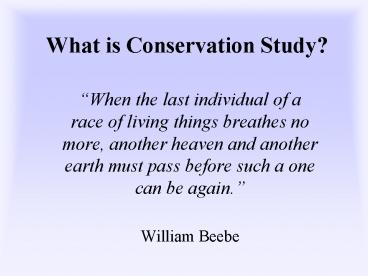What is Conservation Study - PowerPoint PPT Presentation
1 / 23
Title:
What is Conservation Study
Description:
... breathes no more, another heaven and another earth must pass ... Intrinsic value is given to living organisms, species and ... TH. TT. Record ... – PowerPoint PPT presentation
Number of Views:80
Avg rating:3.0/5.0
Title: What is Conservation Study
1
What is Conservation Study?
- When the last individual of a race of living
things breathes no more, another heaven and
another earth must pass before such a one can be
again. - William Beebe
2
Based Upon Value of Biodiversity
- Anthropocentric Value
- Human utilitarian value based upon providing
goods, ecosystem services and information. - Biocentric Value
- Intrinsic value is given to living organisms,
species and biotic communities separate from
human interests. - Not mutually exclusive from anthropocentric value
3
In Response to
- Rapid change in the biosphere due to human
activity, especially over the past 200 years. - Lack of information about living organisms.
- The concept that we should exert caution in
exploiting and eliminating something with
potential value, currently undiscovered.
4
Conservation Ethics Provide Guidance for
Conservation Study
- Modern guiding principles based upon three
philosophical movements of the 19th and 20th
centuries. - Romantic-Transcendental Conservation Ethic
- Resource Conservation Ethic
- Ecological Land Ethic
5
Romantic-Transcendental Ethic
- 19th century writers inspired this ethic
- Ralph Waldo Emerson
- Henry David Thoreau
- John Muir
- Nature was portrayed as a place to refresh the
soul and commune with God. - Anthropocentric
6
Resource Conservation Ethic
- Gifford Pinchot, first director of the Forest
Service under Theodore Roosevelt. - Natural resources should be utilized for the
benefit of the greatest number for the longest
time. - Multiple Use Concept for federal lands.
- Anthropocentric
7
Evolutionary-Ecological Land Ethic
- Aldo Leopold (1949 Sand County Almanac)
- Grew out of resource-based ethic of Pinchot.
- Recognized ecosystems as complex, integrated
systems, not a collection of independent species
to manage separately. - Provided the first biocentric value of the three
major ethics.
8
Managing Populations in Trouble
- Based on scientific principles of ecology,
genetics and evolution. - Incorporates the interests of local people.
- Often facilitated through the United Nations
programs, national governments and local
governments. - Consider economic concerns, cultural influence
and political realities.
9
Understanding Single Population Management
Requires
- Principles of genetics and ecology.
- Principles of mathematics involving population
change over time. - Understanding concepts of evolution.
10
Theoretical non-evolving population
- The frequencies of alleles in a very large
populations gene pool remain constant over time
when - Only random sexual shuffling of alleles due to
sexual reproduction occurs. - No mutation occurs.
- No new alleles are introduced from outside the
population. - No environmental conditions favor one allele form
over another (No natural selection occurs).
11
Consider two allelic forms for a gene, A and a
- The population may have individuals with genotype
- AA or
- Aa or
- aa
- Will the frequency of the AA, Aa or aa genotype
in the population change over time? - Will the frequency of the A allele form and a
allele form in the population change over time?
12
Phenotypes
Genotypes
0.64 0.16
0.8
Gamete Frequency
Therefore Gametes available to make the F1
generation
a 20
A 80
13
ova
F1 Genotype Frequency
p 0.8
q 0.2
p 0.8
P2
pq
sperm
q 0.2
pq
q2
14
Hardy-Weinberg Theorem
p q 1
p2 2pq q2 1
- Assuming a large population with random mating
and no natural selection - The frequency of alleles in a populations gene
pool will remain constant over generations.
15
Evolution of Populations
- Genetic Drift change in allelic frequency due
to sampling error. - Bottleneck Effect dramatic reduction of a
population. - The Founder Effect small populations may start
a new population. - Non-Random mating
- Mutation
- Natural Selection
16
(No Transcript)
17
Try an example! Your cluster is the population.
- Flip a coin two times to determine your genotype.
- AA heads, heads
- Aa heads, tails (or tails, heads)
- aa tails, tails
- Flip the coin to determine your sex.
- Heads Female, Tails Male
- Record your results on a sheet of paper.
- Example Aa female
18
Clouded Leopard
19
Cluster Population Characteristics
- Count and record the number of each genotype in
the room and the number of males and females.
Record these numbers on the board. - Determine the frequency of the genotypes and the
frequency of each individual allele form in the
population.
20
Producing the Next Generation
- Find a mate.
- Set up a Punnett Square.
- Determine all possible genotypes of offspring.
- Determine the genotype of your offspring.
- Determine the sex of your offspring.
- Write this down to give to your offspring.
- Pass the gatekeeper with this information to get
an offspring.
21
Producing the next generation
- 1) Add your genotypes
- 2) Add possible genotypes of offspring
- 3) Flip a coin twice to determine genotype of
offspring - 4) Flip a coin once to determine sex of offspring
22
Record Several Generations
- Follow the changes, or lack of changes in the
frequency of alleles in your population. - What potential problems can you foresee for the
wild population?
23
VORTEX
- Population Software
- Used to review possible trends in small
populations. - After reviewing the software demonstration
identify ways this software may be a useful to to
conservation biologists.































